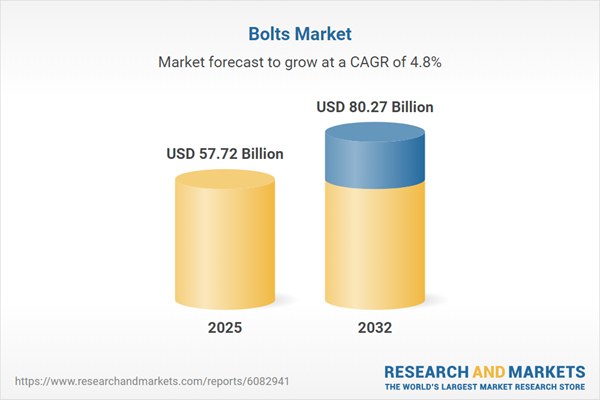Speak directly to the analyst to clarify any post sales queries you may have.
The global bolts market is undergoing rapid transformation, driven by mounting technical, regulatory, and supply chain demands. Senior decision-makers in engineering and procurement must now prioritize integrated strategies to maintain resilience and capture growth opportunities across multiple industrial sectors.
Bolts Market Snapshot
The bolts market grew from USD 55.22 billion in 2024 to USD 57.72 billion in 2025 and is forecasted to continue expanding at a compound annual growth rate (CAGR) of 4.78%, reaching USD 80.27 billion by 2032. This robust expansion is fueled by rising demand in sectors such as aerospace, automotive, construction, energy, and industrial machinery. The market landscape is also shaped by the adoption of advanced materials, increased digitalization in quality and procurement, and evolving supply chain strategies that heighten the importance of supplier traceability and compliance.
Scope & Segmentation
- Product Types: Carriage bolts, hex bolts, lag bolts, machine bolts, U bolts
- Materials: Brass, carbon steel, stainless steel, titanium
- Sizes: Above M30, M1, M10, M15, M20, M30, M5
- Coating Options: Black oxide, galvanized, zinc plated
- End Users: Aerospace, automotive (including commercial and passenger vehicles), construction (commercial, infrastructure, residential), energy (oil & gas, power generation, renewable energy), industrial machinery
- Sales Channels: Offline (direct sales, distributors), online
- Geographic Regions: Americas (North America, Latin America), Europe, Middle East & Africa, Asia-Pacific
- Key Companies: Hilti Corporation, Illinois Tool Works Inc., Adolf Würth GmbH & Co. KG, Aichi Steel Corporation, Ananka Group, Asia Bolts Industries LLC, ATF Inc., BACO Enterprises Inc., Birmingham Fastener & Supply Inc., Boltun Corporation Ltd., Bossard Holding AG, Bulten AB, BUMAX AB, DE FASTENERS INC., Dokka Fasteners AS, Kaloti Group, Kamax Holding GmbH & Co. KG, KOVA Fasteners Pvt Ltd., LISI Group, Meidoh Co. Ltd., MW Industries Inc., Sesco Industries Inc., Southwest Metrics Inc., Stanley Black & Decker Inc., TR Fastenings by Trifast Group, Trifast PLC, TriMas Corporation, Usha Fasteners
Key Takeaways for Decision-Makers
- Strategic bolt selection directly influences product reliability, compliance, and lifecycle costs, necessitating close alignment between engineering, procurement, and regulatory teams.
- Advances in digital workflows, such as electronic traceability and machine-readable certifications, are streamlining approvals and enhancing supplier qualification requirements.
- Sustainable sourcing and lower-carbon material choices are becoming significant differentiators, especially for buyers in infrastructure and renewable energy sectors.
- Regional market dynamics, including fluctuating trade policies and logistics realities, require tailored sourcing and inventory strategies to ensure operational resilience.
- Service differentiation—including kitting, vendor-managed inventory, and local stocking—enhances customer value and shifts competition beyond price alone.
Tariff Impact on Bolts Market
Evolving tariff regimes are compelling organizations to reassess sourcing locations, cost structures, and supplier relationships. Increased duties may prompt nearshoring, substitute material selection, or consolidated purchasing strategies, while driving supplier investment in local production where justified by long-term demand and compliance needs. These shifts make comprehensive landed cost analysis and robust supplier qualification processes crucial for effective risk management across the supply chain.
Primary Keyword: Bolts Market
With evolving quality standards, heightened emphasis on traceability, and changing buyer expectations, the bolts market is witnessing a shift from commodity competition to value-driven supply partnerships. Integrated digital platforms, advanced metallurgical controls, and end-to-end supply visibility now define best-in-class performance across the sector.
Methodology & Data Sources
This report integrates insights from structured executive interviews, facility observations, and standards analysis. It draws from technical, commercial, and regulatory perspectives, supplementing primary findings with public filings and verified supplier documentation. This multi-method approach supports actionable, evidence-based recommendations for leadership teams.
Why This Report Matters
- Delivers practical insights supporting risk mitigation and streamlined procurement in an increasingly complex bolts market.
- Enables cross-functional leaders to identify growth opportunities by aligning technical requirements, regulatory compliance, and service differentiation strategies.
- Guides investments in traceability, supplier performance, and sustainability to strengthen supply chain resilience and customer value.
Conclusion
Sustained success in the bolts market relies on cross-functional strategy, technology adoption, and responsive supply management. This report equips leaders to navigate shifting requirements, anticipate regulatory impacts, and drive value through integrated supply solutions.
Table of Contents
3. Executive Summary
4. Market Overview
7. Cumulative Impact of Artificial Intelligence 2025
Companies Mentioned
The companies profiled in this Bolts market report include:- Hilti Corporation
- Illinois Tool Works Inc.
- Adolf Würth GmbH & Co. KG
- Aichi Steel Corporation
- Ananka Group
- Asia Bolts Industries LLC
- ATF Inc.
- BACO Enterprises Inc.
- Birmingham Fastener & Supply, Inc.
- Boltun Corporation, Ltd.
- Bossard Holding AG
- Bulten AB
- BUMAX AB
- DE FASTENERS INC.
- Dokka Fasteners AS
- Kaloti Group
- Kamax Holding GmbH & Co. KG
- KOVA Fasteners Pvt Ltd.
- LISI Group
- Meidoh Co., Ltd.
- MW Industries, Inc.
- Sesco Industries Inc.
- Southwest Metrics, Inc.
- Stanley Black & Decker, Inc.
- TR Fastenings by Trifast Group
- Trifast PLC
- TriMas Corporation
- Usha Fasteners
Table Information
| Report Attribute | Details |
|---|---|
| No. of Pages | 194 |
| Published | October 2025 |
| Forecast Period | 2025 - 2032 |
| Estimated Market Value ( USD | $ 57.72 Billion |
| Forecasted Market Value ( USD | $ 80.27 Billion |
| Compound Annual Growth Rate | 4.7% |
| Regions Covered | Global |
| No. of Companies Mentioned | 29 |









